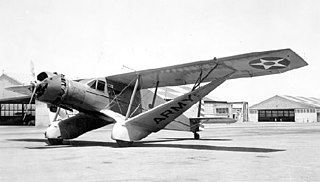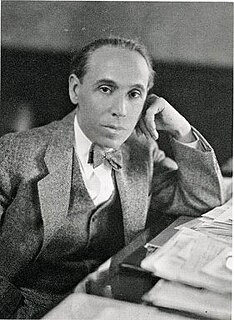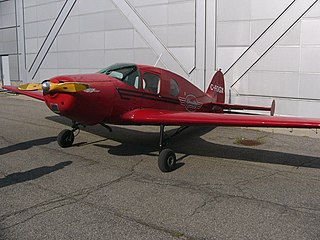Development
In 1916, the Maryland Pressed Steel Company hired Giuseppe Mario Bellanca to develop a two-seat biplane with intention to sell examples to the government during the war effort.
The two-seat plane was built at the Pope Avenue factory in Hagerstown, Maryland. [1]
Bellanca had previously designed his own parasol aircraft in Sicily, bring the examples to New York to test fly. The Bellanca Aeroplane Company and Flying School was formed in 1911 at Mineola Long Island New York, where Bellanca taught the mayor, Fiorello LaGuardia.

The Bellanca Aircruiser and Airbus were high-wing, single-engine aircraft built by Bellanca Aircraft Corporation of New Castle, Delaware. The aircraft was built as a "workhorse" intended for use as a passenger or cargo aircraft. It was available with wheels, floats or skis. The aircraft was powered by either a Wright Cyclone or Pratt and Whitney Hornet engine. The Airbus and Aircruiser served as both commercial and military transports.

The American Champion 8KCAB Decathlon and Super Decathlon are two-seat fixed conventional gear light airplanes designed for flight training and personal use and capable of sustaining aerobatic stresses between +6g and −5g. The Decathlon entered production in the United States in 1970 as a more powerful and stronger complement to the American Champion Citabria line of aircraft.

Giuseppe Mario Bellanca was an Italian-American aviation pioneer, airplane designer and builder, who is credited with many design firsts and whose aircraft broke many aviation records. He was inducted into the National Aviation Hall of Fame in 1973. The Bellanca C.F., the world's first enclosed-cabin monoplane, is on display at the National Air and Space Museum. Bellanca was known mostly for his long range aircraft which led the way for the advancement of international and commercial air transportation.

The Bellanca Viking and Super Viking are a series of single-engine, four-seat, high performance, retractable gear aircraft manufactured in the USA during the 1960s and 1970s. The aircraft developed through modifications of classic designs by the aviation pioneer Giuseppe Bellanca. A total of 1,356 Vikings have been produced with most production between 1968 and 1975.

The Avro Type E, Type 500, and Type 502 made up a family of early British military aircraft, regarded by Alliott Verdon Roe as his firm's first truly successful design. It was a forerunner of the Avro 504, one of the outstanding aircraft of the First World War.

The Bellanca 28-90 Flash was an American military aircraft derived from an earlier air racer developed in the 1930s for export to Spain to take part in the Spanish Civil War. Although it never reached Spain, the order was diverted to China where the aircraft briefly saw service. Later, a new batch destined for Spain ended up in Mexico.

The Bellanca 14-7 and its successors were a family of light aircraft manufactured in the United States shortly before World War II.

The Bellanca 14-13 Cruisair Senior and its successors were a family of light aircraft that were manufactured in the United States by AviaBellanca Aircraft after World War II. They were a follow-up to the prewar Bellanca 14-7 and its derivatives.

The Fairchild 22 Model C7 was an American two-seat touring or training monoplane designed and built by the Kreider-Reisner division of the Fairchild Aircraft Corporation at Hagerstown, Maryland.

The American Eagle A-129 was a 1920s biplane built in the U.S.A.

The Eagle DW.1 is an American-built single-seat agricultural biplane of the late 1970s.

The BFW M.21 was a single-engined biplane trainer designed by Willy Messerschmitt for the German Ministry of Transport. It was one of only two biplanes Messerschmitt designed, neither reaching production.

The Fisher FP-404 is a Canadian single-seat, conventional landing gear, single-engined biplane kit aircraft designed for construction by amateur builders. Fisher Flying Products was originally based in Edgeley, North Dakota, USA but the company is now located in Woodbridge, Ontario, Canada.
The Fisher Horizon is a family of Canadian two-seats-in-tandem, conventional landing gear, single-engined, high-wing monoplane kit aircraft designed for construction by amateur builders. The Horizon 1 was inspired by the Aeronca Champion and its later version, the Bellanca Citabria, while the Horizon 2 was inspired by the Cessna O-1 Bird Dog.

The Kreider-Reisner KR-21-A was a 1928 American two-seat monoplane. It was designed and built by the Kreider-Reisner Aircraft Company of Hagerstown, Maryland. Fairchild Aircraft took over Kreider-Reisner in 1929 and continued to build them, as the Fairchild KR-21, later the Fairchild 21.
Maryland Pressed Steel Company was an American aircraft manufacturer of the Bellanca CD, and CE aircraft.
The Bellanca CD was the first aircraft designed for the Maryland Pressed Steel Company, by the aircraft designer Giuseppe Mario Bellanca. The aircraft was also called the Bellanca C.D. or the "CD Tractor Biplane".

The sole Wright-Bellanca WB-2, named Columbia, Miss Columbia, and later Maple Leaf, was the second in a series of aircraft designed by Giuseppe Mario Bellanca, initially for Wright Aeronautical then later Columbia Aircraft Corp.

The Bellanca CF is an early enclosed high-wing monoplane designed by Giuseppe Mario Bellanca that led to a successful series of Bellanca aircraft. Bellanca was nominated for the Collier Trophy in 1922 for the CF design.

The Kreider-Reisner Midget was an American light racing monoplane, the first aircraft designed by the Kreider-Reisner Aircraft Company of Hagerstown, Maryland.

















